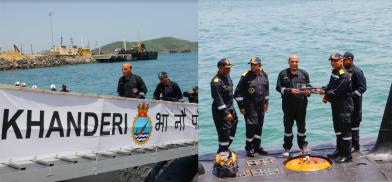The Indian Navy's three-dimensional capabilities
“Today, Indian Navy is counted among the frontline navies of the world. Today, the world’s largest maritime forces are ready to work and cooperate with India,” Singh said and described INS Khanderi as a shining example of the ‘Make in India’ capabilities of the country.

Defence Minister Rajnath Singh was on a sea sortie on one of Indian Navy’s most potent platforms, INS Khanderi, during his visit to the Karwar Naval Base in Karnataka on May 27. He was given a first-hand insight into the combat capabilities and offensive strength of the state-of-the-art Kalvari class submarine. For over four hours, the full spectrum of capabilities of underwater operations of the stealth submarine was demonstrated to the Minister.
In the past couple or more of decades, Indian President A.P.J. Abdul Kalam was the first to undertake a submarine sortie. He and President Pratibha Patil-and a number of Defence Ministers have flown on supersonic jets of the Indian Air Force and have often visited or sailed on Indian Navy’s battleships. But Rajnath Singh is the first Defence Minister to sail on/in a submarine.
George Fernandes was the only defence minister who visited the Siachen Glacier 40 times -- each time on a fixed and rotary winged aircraft (helicopter), with the latter in very challenging flying conditions.
Day-at-sea
During his submarine sojourn, Rajnath Singh witnessed a wide range of operational drills with the submarine demonstrating the advanced sensor suite, combat system and weapon capability which provides it with a distinct advantage in the subsurface domain. The day-at-sea also provided him a glimpse of the submarine’s capability to effectively counter anti-submarine operations by an adversary. Chief of Naval Staff Admiral R Hari Kumar and other officials of the Indian Navy and Defence Ministry were present.
Complementing the crew of the submarine for carrying out operations in a challenging environment and the Indian Navy for maintaining a high state of readiness and offensive capability to deal with any threat in the maritime domain, Singh thereafter termed the Indian Navy as a modern, potent and credible force, capable of being vigilant, valiant and victorious in all situations.
“Today, Indian Navy is counted among the frontline navies of the world. Today, the world’s largest maritime forces are ready to work and cooperate with India,” Singh said and described INS Khanderi as a shining example of the ‘Make in India’ capabilities of the country.
Navy’s clout
He appreciated the fact that 39 of the 41 ships/submarines ordered by the Indian Navy were being built in Indian shipyards. The number of platforms and the speed at which they have been launched by the Indian Navy has strengthened the resolve of achieving ‘Aatmanirbhar Bharat’ (self-reliant India) as envisioned by Prime Minister Narendra Modi.
On the commissioning of India’s first indigenous aircraft carrier Vikrant, expected by August 2022, Singh said it will bolster the maritime security of the country along with INS Vikramaditya. He, however, assured that the preparations being made by the Indian Navy are not a provocation to any aggression but a guarantee of peace and security in the Indian Ocean region.
INS Khanderi’s operational sortie was accompanied by the deployment of ships of the Western Fleet, an anti-submarine mission sortie by a P-8I MPA and Sea King helicopter, a fly past by MiG 29-K fighters and a search and rescue capability demonstration.
Having embarked on the aircraft carrier INS Vikramaditya in September 2019 and flown in a sortie on the P8I Long Range Maritime Reconnaissance Anti-Submarine Warfare aircraft and sailed in the submarine, both in May 2022, the Defence Minister has witnessed first-hand the three-dimensional combat capability of the Indian Navy.
INS Khanderi
INS Khanderi is the second of six Kalvari class Scorpene submarines of Project 75, built under the ‘Make in India’ initiative at Mazagon Docks Ltd, Mumbai. INS Khanderi was commissioned by Singh on September 28, 2019. Four of the six Scorpene submarines designed by French naval shipbuilder Naval Group and manufactured by Mazagon Dock and commissioned are INS Kalvari, INS Khanderi, INS Karanj and INS Vela. Of the two submarines that remain to be inducted in the Indian Navy, one is undergoing sea trials. The sixth submarine already launched is likely to be delivered by the first quarter of 2024.
Scorpene submarines are extremely potent platforms, with advanced stealth features and equipped with both long-range guided torpedoes as well as anti-ship missiles. These submarines have a state-of-the-art SONAR (sound navigation and ranging, a technique that uses sound propagation to navigate, measure distances, communicate with or detect objects and sensor suite permitting outstanding operational capabilities). The induction of these submarines has significantly enhanced the Indian Navy’s underwater capability in the Indian Ocean Region.
In June 2021, the Defence Acquisition Council (DAC), chaired by Defence Minister Singh, formally cleared India’s ambitious but long-delayed Rs.43,000-crore project to build six more new-generation stealth submarines with foreign collaboration under the strategic partnership model. Proposed to be built under Project 75 (I) (I for India), the aim is to construct six conventional submarines with better sensors and weapons and the Air Independent Propulsion System (AIP), which enables the submarine to remain submerged for much longer periods.
However, Naval Group India has reportedly turned down the proposal as the French Navy does not use the AIP system. Does this mean that Mazgaon Dock’s submarine division raised at great cost will remain unused?
(The author is former spokesman Ministry of Defence, India. Views are personal)









Post a Comment